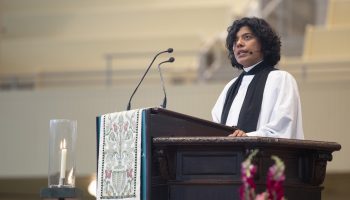“When I went to find women who speak in the Gospels, it didn’t take long. We rarely hear the Scriptures where they are included,” said the Rev. Winnie Varghese at the 9:15 a.m. Monday morning worship service on Aug. 20.
Her sermon title was “Blessed is She Who Believed,” and the Scripture text was Luke 1:39-45, Mary’s visit to her cousin Elizabeth.
Varghese said she was inspired in her search by artist Dylan Marron.
In 2015, Marron set out to find every single word said by a person of color in a major Hollywood film. He spliced these clips together into a film: “Every Single Word.”
“The clips ranged from under 10 seconds to 15 minutes at the most in regular-length films,” Varghese said.
“Blessed is she who believed,” is Elizabeth’s blessing on Mary when she visited Elizabeth. Her baby had leapt in her womb at the sound of Mary’s voice.
In Harper’s Magazine in 2006, photojournalist Peter Turnley had a photo story looking from the Mexican side of the border with the United States.
One photo remained with Varghese. It was of Ubencia Sánchez, in profile, her long hair blowing in the wind.
“She is standing high and looking over the corrugated metal that was the border wall,” Varghese said. “Both sides look the similar; I don’t know what state she was looking at.”
Sánchez was from Chiapas.
“She wore a thin blue housedress, the gown of working women all over the world. She was very thin, but she had a strong face like Geronimo or Crazy Horse,” Varghese said.
Varghese wondered what Sánchez had seen on her journey and where she is today.
“I hope she willed herself to whatever she desired,” Varghese said. “Do we believe in the promise of the United States like her, an outsider who wants to get here to be with us?”
The image of the corrugated steel wall reminded Varghese of the altar rail in church.
When she was growing up, the rail seemed very high. She would look reverently at the “holy stuff” on the other side of the rail, where no girls were allowed.
“The sacred things came to us,” she said.
The wall on the border is an altar rail, a barrier to new life for people like Sánchez.
“What has she heard, to risk everything to be with us?” Varghese said.
In Luke’s Gospel, Elizabeth shows us how to be a mother, Varghese told the congregation. She was able to gather up Mary, protect her at a fragile time, and bless her.
“Sometimes when I feel fragile, I feel like I should fling a blessing at someone,” Varghese said. “Maybe that is a special gift of older women.”
She said that we don’t spend time on this passage because it leads directly into the Magnificat, which takes away our attention.
“I imagine Ubencia, gazing over the wall at hope” Varghese said. “It makes my stomach turn to think what might have happened to her.”
As Elizabeth did for Mary, Varghese did for Ubencia.
“Blessed are you, my dear,” she said. “Blessed are you and from that blessing comes the song of the ages.”
The Rt. Rev. V. Gene Robinson, vice president of religion and senior pastor at Chautauqua, presided. The Rev. Virginia Carr, rector of St. Peter’s Episcopal Church in Westfield and vicar of the Episcopal Chapel of the Good Shepherd, read the Scripture. Under the direction of Jared Jacobsen, organist and coordinator of worship and sacred music, the Motet Choir sang “Come Unto Me” by Pyotr Ilyich Tchaikovsky, arranged by Christopher O’Hare. The Mr. and Mrs. William Uhler Follansbee Memorial Chaplaincy and the Daney-Holden Memorial Fund provide support for this week’s services.





